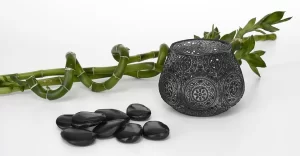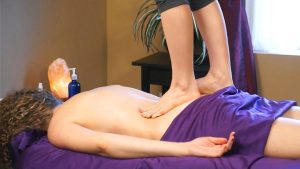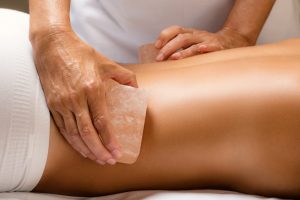Deep tissue massage is an effective and targeted procedure aimed at addressing issues with muscle tension, pain, and restricted mobility. This type of massage is a powerful tool in improving physical well-being and overall health. In this article, we will explore what deep tissue massage is, the benefits it offers, the process of a session, and conditions that require special attention. Delving deeper into the world of massage means gaining a deeper understanding of your health.
Benefits of Deep Tissue Massage:


- Reducing Muscle Tension: Targets muscles thoroughly, promoting relaxation even in the most tense areas.
- Pain and Spasm Relief: Addresses hidden sources of pain by relaxing muscles, relieving pain and spasms.
- Improved Joint Mobility: Work on deep tissues contributes to enhanced joint mobility.
- Enhanced Blood Circulation: Stimulates circulation, increasing oxygen and nutrient delivery to body cells, aiding in their recovery.
- Long-Term Results: Unlike some other practices, the effects of this type of massage often last for an extended period, providing long-term relief.
- Endorphin Release: Promotes the release of endorphins, natural analgesics that help improve mood and overall psychological well-being.
How a Deep Tissue Massage Session Proceeds:


- Consultation: A conversation with the massage therapist where you discuss your main concerns, desired outcomes, and medical history.
- Session Preparation: You will be asked to undress and comfortably lie on the massage table.
- Start of the Session: The massage therapist will begin by working slowly and systematically on superficial muscle layers, gradually transitioning to deeper tissues.
- Application of Pressure: The therapist uses various techniques and applies different levels of pressure to reach deep tissues, utilizing hands, fingers, and elbows.
- Special Attention to Problem Areas: Focus on areas with increased tension, pain, or restricted mobility.
- Communication with the Massage Therapist: It’s crucial to maintain communication during the session to specify the level of pressure, comfort, and the effectiveness of the procedure.
- Session Conclusion: The therapist uses lighter touches and techniques to smoothly transition to a state of maximum relaxation.
- Post-Session Consultation: After the session, the therapist provides recommendations for aftercare, exercises, or additional measures to solidify positive results.
Indications and Contraindications


Indications:
- Muscle tension and spasms.
- Chronic pain in muscles and joints.
- Sports injuries.
- Limited mobility.
- Stress and anxiety.
Contraindications:
- Acute injuries.
- Oncological diseases.
- Inflammatory processes.
- Cardiovascular issues.
- Thrombosis and varicose veins.
- Pregnancy
Qualification of the Massage Therapist:


Choosing a qualified massage therapist is a crucial step for a safe and effective experience. Key considerations include education, certification, experience, client reviews, understanding of medical aspects, and communication skills.
Maintaining the Results of Deep Tissue Massage
After completing sessions, active involvement in maintaining achieved results is essential. Recommendations include regularity of sessions, daily physical activity, hydrotherapy, proper nutrition and hydration, maintaining good posture, home exercises and stretches, self-massage of problematic areas, listening to your body, regular consultations with a professional, and engaging in activities like yoga.
Questions and Answers:
What is deep tissue massage?
A deep tissue massage is a type of massage therapy that focuses on realigning deeper layers of muscles and connective tissues. It is especially beneficial for aiding chronic muscle tension and injuries.
How does deep tissue massage work?
Deep tissue massage uses firm pressure and slow strokes to reach the deep layers of muscle and connective tissue. By breaking up scar tissue and reducing muscle tension, it can help relieve chronic pain and improve mobility.
What are the benefits of deep tissue massage?
Deep tissue massage may help in reducing pain and addressing various conditions, including low back and back pain, by targeting the deeper layers of muscle and connective tissue.
What is the difference between deep tissue massage and Swedish massage?
Swedish massage tends to be more gentle and focused on relaxation, while deep tissue massage is a more intense therapy that targets deeper layers of muscle to address muscle and connective tissue issues.
Can deep tissue massage help with sports injuries?
Yes, deep tissue massage can be beneficial for addressing sports injuries by targeting the deep layers of muscle and connective tissue to aid in recovery and reduce muscle tension.
Is deep tissue massage a form of therapeutic massage?
Yes, deep tissue massage is a form of massage therapy that aims to relieve tension and pain by applying deep pressure and strokes to reach the deep layers of muscle.
How does deep tissue massage help in reducing chronic pain?
Deep tissue massage targets the deep layers of muscle and connective tissue, which can help in breaking up scar tissue and reducing muscle tension, ultimately leading to a reduction in chronic pain.
How often can deep tissue massage sessions be conducted?
The frequency depends on individual needs, but it is generally recommended to have sessions 1-2 times a week initially, then transitioning to maintenance sessions.
What role does hydrotherapy play in maintaining the results of massage?
Warm baths and wraps help relax muscles and reduce potential inflammation.












![11 Best Alternatives to Bedpage: Your Ultimate Guide [March 2024]](https://massage.dating/wp-content/uploads/2024/03/Best-Alternatives-to-Bedpage-300x200.jpg)





















































































































